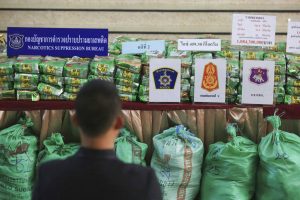The trafficking of synthetic drugs in East and Southeast Asia continues at near-record levels, the United Nations said on Friday, noting the emergence of new smuggling routes for methamphetamine and a spike in the production of ketamine.
In its annual report on the Asian synthetic drug market, which was released Friday, the U.N. Office of Drugs and Crime (UNODC) stated that large amounts of methamphetamine continue to be produced in eastern Myanmar. This is then trafficked to the world market via Thailand and Laos, as well as new routes through central Myanmar.
“Traffickers have continued to ship large volumes through Laos and northern Thailand,” Jeremy Douglas, UNODC Regional Representative for Southeast Asia and the Pacific, said in a statement accompanying the report’s release. “At the same time, they have pushed significant supply through central Myanmar to the Andaman Sea where it seems few were looking.”
Total seizures of methamphetamine returned to pre-COVID-19 levels, declining from 171.5 tons in 2021 to just under 151 tons last year, but still nearly double the 82.5 tons seized in 2017.
In general, decreased seizures can be read in one of two ways, as reflecting either a drop in the amount of drugs being trafficked or the fact that traffickers have simply become more adept at evading anti-drug efforts. In this case, the UNODC seems to suggest the latter. The report observes that law enforcement efforts have intensified in China’s Yunnan province and along the Thai border with Myanmar. While this has resulted in a large drop in methamphetamine seizure levels in China and a slight decrease in Thailand, this seems to have pushed drug syndicates into employing new routes – particularly maritime routes – for large drug shipments.
“Despite a leveling of methamphetamine seizures to pre-pandemic levels… other indicators – arrests, street availability, purity, record low wholesale and street prices, and treatment admissions – indicate the supply has remained very high or unchanged,” the report stated. According to UNODC, wholesale and street prices of methamphetamine remained at, or fell to, record lows in 2022 across the region.
As has been the case since the first decade of the 2000s, the UNODC report states, the main locus of Asia meth production was Myanmar’s Shan State, which is blessed with a number of “favorable conditions” for drug production. These include the region’s geographical remoteness, fractured state jurisdictions, and proximity to China and Southeast Asian drug and precursor markets.
“Asian organized crime groups have partnered with non-state armed groups in Shan, particularly those within the Special Regions (SRs), over the last decade,” the report stated, referring to four rebel-held territories that were created via ceasefires with the central government in the late 1980s. Production in Myanmar has been fueled by the political chaos that has followed the military’s seizure of power in February 2021.
The report also notes the increasing salience of Laos, both as a transshipment point for methamphetamine from Shan State and as a locus of drug production. As it states, “there have also been methamphetamine tableting operations detected in the country in
recent years, demonstrating the geographical connectivity and related networks between Shan and northern Lao PDR for illicit drug production.” UNODC noted smaller production in China, Indonesia, Malaysia, and the Philippines.
Another notable finding in the report is Authorities in the region have also seized a record 27.4 tons of ketamine in 2022, an increase of 167 percent from a year earlier.
“The ketamine situation in the region in many ways mirrors the supply-driven approach used to expand the methamphetamine market in the mid-2010s,” Inshik Sim, the UNODC’s regional coordinator on synthetic drugs, said in the agency’s statement. “That being said, information on ketamine use is limited, and it is unclear how widespread it is – research is badly needed.”
































